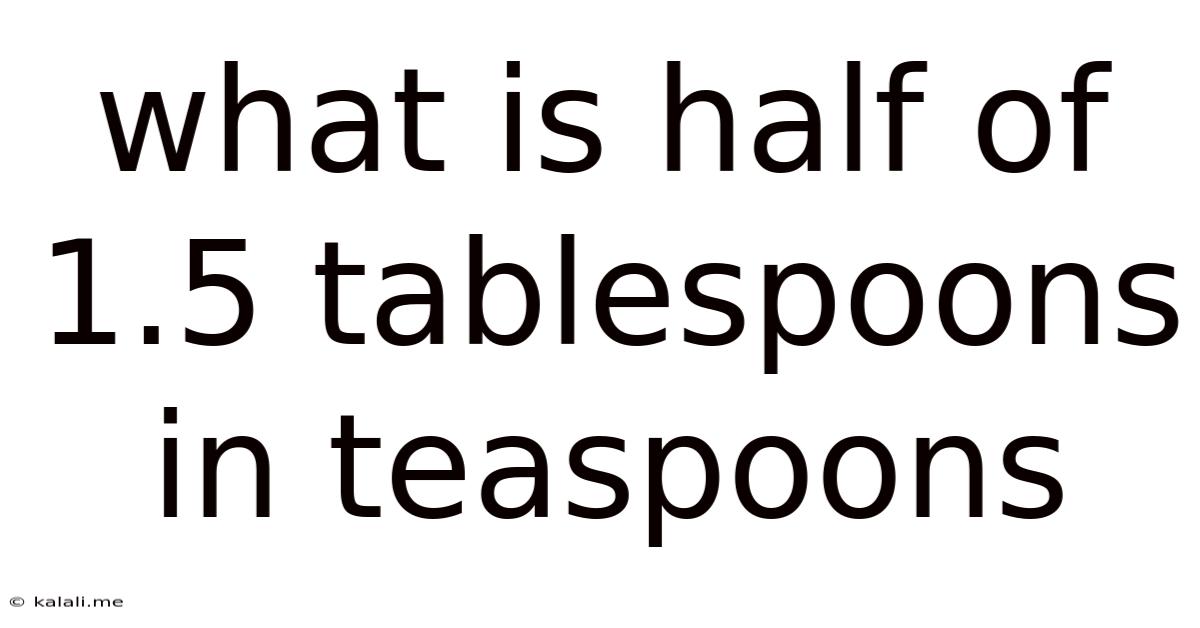What Is Half Of 1.5 Tablespoons In Teaspoons
Kalali
Aug 05, 2025 · 4 min read

Table of Contents
What is Half of 1.5 Tablespoons in Teaspoons? A Comprehensive Guide to Culinary Conversions
This seemingly simple question – "What is half of 1.5 tablespoons in teaspoons?" – opens a door to a wider world of culinary measurements and conversions. Understanding these conversions is crucial for bakers, cooks, and anyone striving for consistent results in the kitchen. This article delves deep into the answer, providing not only the solution but also a comprehensive understanding of the underlying principles and practical applications. We'll explore the relationship between tablespoons and teaspoons, discuss common conversion errors, and offer tips for accurate measurement in your cooking and baking endeavors.
Understanding the Basics: Tablespoons and Teaspoons
Before diving into the calculation, let's establish a solid foundation. The tablespoon (tbsp) and teaspoon (tsp) are common units of volume in many culinary recipes. They're not standardized universally; minor variations exist depending on region and the type of measuring spoon. However, the most widely accepted standard equates 1 tablespoon to 3 teaspoons. This ratio is crucial for all our conversion calculations.
Calculating Half of 1.5 Tablespoons
Now, let's tackle the central question: What is half of 1.5 tablespoons in teaspoons?
-
Find half of 1.5 tablespoons: 1.5 tablespoons / 2 = 0.75 tablespoons
-
Convert tablespoons to teaspoons: Since 1 tablespoon equals 3 teaspoons, we multiply the number of tablespoons by 3: 0.75 tablespoons * 3 teaspoons/tablespoon = 2.25 teaspoons
Therefore, half of 1.5 tablespoons is equal to 2.25 teaspoons.
Practical Applications and Real-World Scenarios
Understanding this conversion isn't merely an academic exercise; it's a practical skill applicable in countless culinary situations. Imagine you're following a recipe that calls for 1.5 tablespoons of baking powder, but you only want to make half the recipe. Knowing that half of 1.5 tablespoons is 2.25 teaspoons allows you to adjust the recipe accurately, ensuring the final product maintains its desired texture and taste.
Common Measurement Errors and How to Avoid Them
Even experienced cooks can fall prey to measurement errors. Here are some common mistakes and how to avoid them:
-
Using inaccurate measuring spoons: Ensure your measuring spoons are calibrated correctly. Over time, they can become bent or warped, leading to inaccurate measurements. Consider investing in a set of high-quality measuring spoons.
-
Overfilling measuring spoons: Don't pack ingredients into the spoon; instead, gently level them off with a straight edge (like a butter knife). Packing ingredients leads to inaccurate measurements, especially with powdered ingredients like baking powder or sugar.
-
Using different measuring systems: Be mindful of the measuring system used in the recipe (e.g., metric versus imperial). If the recipe uses both systems, double-check your conversions to avoid mistakes.
-
Ignoring significant figures: When dealing with fractions, pay attention to significant figures. Rounding too early in the calculation can lead to inaccuracies in the final measurement. In our example, maintaining the precision of 2.25 teaspoons is vital for accurate baking.
Beyond the Basics: Expanding Your Culinary Conversion Skills
Mastering the tablespoon-to-teaspoon conversion is just the beginning. Expanding your knowledge of culinary conversions opens up a world of possibilities in the kitchen. Here's how you can improve your culinary math skills:
-
Learn other common conversions: Familiarize yourself with conversions between cups, ounces, milliliters, and grams. Understanding these conversions empowers you to adapt recipes and work with different units of measure.
-
Use online conversion tools: Numerous online conversion tools and calculators are available to simplify the process. These tools are especially helpful when dealing with more complex conversions or less common units of measure.
-
Practice regularly: The more you practice, the more comfortable and accurate you'll become with culinary conversions. Start with simple conversions and gradually work your way up to more complex ones.
-
Understand the context of the recipe: The importance of precise measurement varies depending on the recipe. Some recipes are more forgiving than others. For example, a small variation in the amount of salt might not drastically affect the outcome, but an inaccurate measurement of baking powder could significantly impact the rise of a cake.
The Importance of Accurate Measurement in Baking vs. Cooking
Accurate measurement is significantly more crucial in baking than in cooking. In baking, precise measurements are essential for chemical reactions to occur correctly, ensuring the desired texture and rise of baked goods. In contrast, cooking often allows for more flexibility; small variations in ingredient amounts often have less impact on the final result.
Conclusion: Mastering Culinary Conversions for Kitchen Success
Mastering the art of culinary conversions, starting with understanding that half of 1.5 tablespoons is 2.25 teaspoons, elevates your cooking and baking skills. It allows you to adapt recipes, experiment with new ingredients, and achieve consistent, delicious results every time. By paying close attention to detail, using accurate measuring tools, and practicing regularly, you can confidently navigate the world of culinary measurements and create culinary masterpieces. Remember to always double-check your measurements and understand the context of your recipe for optimal results. Happy cooking and baking!
Latest Posts
Latest Posts
-
How Many Square Feet In A Lot
Aug 07, 2025
-
Should I Wash My Hair Before A Perm
Aug 07, 2025
-
The Most Diverse Classical Music Period Was
Aug 07, 2025
-
1996 Chevy Silverado Radio Wiring Harness Diagram
Aug 07, 2025
-
How Many Eighths Are In A Quarter
Aug 07, 2025
Related Post
Thank you for visiting our website which covers about What Is Half Of 1.5 Tablespoons In Teaspoons . We hope the information provided has been useful to you. Feel free to contact us if you have any questions or need further assistance. See you next time and don't miss to bookmark.